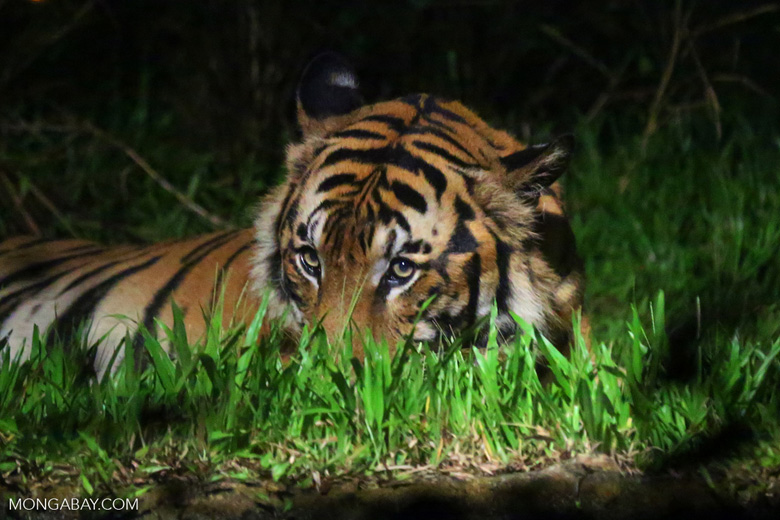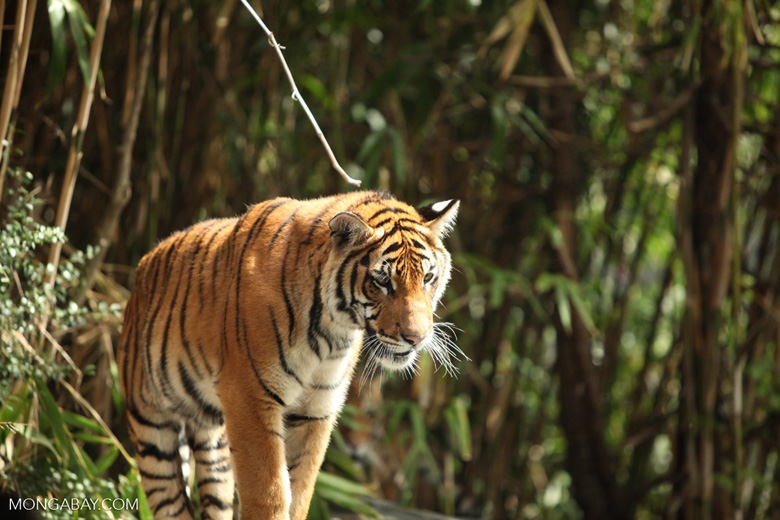- The remains were found in a car leaving Wat Pha Luang Ta Bua. Three monks and two temple devotees have been charged.
- The seizure falls on the heels of the discovery of 40 dead tiger cubs in a temple freezer. Federal officials have filed a criminal complaint against the temple, with temple officials facing up to four years in prison and fines if found guilty of smuggling the animals.
- The temple housed more than a hundred tigers, as well as other wildlife, purportedly used as a tourist attraction.
- Conservationists suspect the temple was involved in trafficking the remains. This, they say, is driving up the demand for black market tiger parts, which are increasingly seen as status symbols in Asia and putting wild tigers at higher risk of poaching.
Update: 22 people have been charged with wildlife trafficking as of June 3. More dead animals, including a bear and a leopard, have been discovered and removed from the temple.
Today, June 2, just a day after Department of National Parks (DNP) and Wildlife Conservation Office (WCO) officials found 40 dead tiger cubs in a kitchen-area freezer on-site at a Buddhist monastery, authorities caught a monk trying to leave the premises with tiger skins and fangs.
The seizure was made at the now-infamous “Tiger Temple” (officially called Wat Pha Luang Ta Bua) of Kanchanaburi, Thailand. The temple was a tourist attraction where visitors could take selfies and even hand-feed the Buddhist monastery’s 137 captive tigers.
“Today we found tiger skins and amulets in a car which was trying to leave the temple,” Adisorn Noochdumrong, Deputy Director General of Thailand’s national parks department told AFP news agency. By the end of the day, Reuters reported authorities had charged three Buddhist monks and two temple devotees who were caught trying to smuggle these tiger skins and parts outside the temple.
On Wednesday, officials also recovered a live lion, several hornbills, a sun bear, a banteng (an endangered species of wild cattle), a bearcat, and deer antlers inside the temple premises according to a report by Channel News Asia. According to The Guardian, a search of monks’ quarters on Thursday revealed “two full-body tiger skins, about 10 fangs and dozens of pieces of tiger fur.” Adisorn and his team also found 20 jars of preserved tiger parts containing “both whole bodies and organs to be used for medicines,” Adisorn said, according to a report by Channel News Asia. Authorities now believe the cubs were being preserved for use in potions and traditional medicine.
A history of suspicion
Conservationists, international organizations and animal rights activists alike have long been calling the temple a front for wildlife trafficking and accusing staff of abusing the animals. Even though the temple staff has always denied all allegations, these latest discoveries cast a definite shadow of doubt upon its operations.
In 2001, Thailand’s government “seized” the temple’s tigers for lack of any legal permission to have an endangered species on its site. It was, however, allowed to continue caring for the tigers under the condition that it would not use them for trade and would not breed them. However, over the next two years, conservationists say the temple’s tiger population nearly doubled.

Then, in December 2014, three micro-chipped, healthy adult male tigers suddenly vanished from their cages. Australian NGO Cee4Life conducted a nine-year investigation into the Tiger Temple. Their report includes an audio clip that purports to show a former vet, the Abbot and a senior temple adviser discussing the temple’s involvement in wildlife trafficking. It also contains a detailed spreadsheet that allegedly accounts for all the temple’s tigers, including those that were illegally obtained from the wild and “went missing.” The report outlines how the three tigers were “taken from the temple at the direction of the Abbot, they were killed – and that tigers have been traded in and out of the tiger temple since at least 2004. Other evidence documents cross-border trades with tiger farms in Laos.”
This past Monday, May 31, Thailand’s police and wildlife officials began an operation to capture and relocate all living tigers in the temple compound after obtaining legal permission to conduct a raid. The temple’s monks refused to let authorities in at first but after a half-hour standoff, authorities entered the area – yet they faced another obstacle. Teunchai Noochdumrong, director of WCO told CNN, “When our vet team arrived, there were tigers roaming around everywhere. (It) looks like the temple intentionally let these tigers out, trying to obstruct our work.”
While officials were tranquilizing and relocating the live tigers, Teunchai Noochdumrong told Reuters, “Foreign volunteers at the temple today told us about it (the frozen cubs) and showed us the freezer. Perhaps, they felt what the temple is doing isn’t right.” The tiger cubs, she said, “must be of some value for the temple to keep them. But for what, is beyond me.”
The Tiger Temple, on its Facebook page, claims that the discovery of the dead tiger cubs, does not prove its compliance or involvement in any illicit activities. They claim they were merely following protocol left in place by a former veterinarian, Dr. Somchai Visasmongkolchai, who had recommended that the temple freeze the animals that die on its property instead of continuing to cremate them so as to have proof against allegations that they were selling tiger cubs and supplying the black market for illegal wildlife trade.
The temple even alleged that DNP officials knew of the freezer’s contents. However, Teunchai Noochdumrong told Reuters that her office had no prior knowledge of this. “The temple has notified us when grown tigers die, but never the cubs,” she said.
The discovery of the bodies, Teunchai Noochdumrong told CNN, is proof that the temple violated an agreement that they would inform the WCO if new cubs were born at the temple. She also said that if found attempting to smuggle the tiger cubs’ remains, temple officials could face up to four years in jail and/or be fined up to $1,121 (THB 40,000).
Officials will be conducting DNA tests on the seized live tigers and the dead cubs to see how and if they are related. According to the New York Times, “Wildlife officials said that only one of the dead cubs found on Wednesday had been reported to the government as required by law.”
The lucrative, illegal tiger trade
According to Debbie Banks, leader of the campaign on tigers and wildlife crime at the Environmental Investigation Agency (EIA), while adult tigers have more value on the black market for their pelt, teeth and claws, cubs are also trafficked for their meat and bones. Although illegal, there is a huge demand in Asia for tiger parts often used in traditional medicine even though alternative pharmaceutical options are now widely available and many of the tigers’ perceived medicinal properties have been disproved by science.
This trade in tiger parts has long been driving the decline of wild tiger populations in range countries like India, Nepal and Bangladesh, and Thailand is a known hub for illegal trade in wildlife. A 2010 survey estimated the total global wild tiger population at around 2,500 adults, down from 5,000 to 7,000 in 1998. Both the tiger species (Panthera tigris) and the Bengal subspecies (Panthera tigris tigris) – the most widespread tiger in Asia – are listed as Endangered by the IUCN.

In addition to the traditional medicine market, another driver of tiger trafficking is emerging: tiger parts are increasingly seen as status symbols.
“Wealth (is) replacing health as a primary form of consumer motivation,” reads the Cee4Life report. Tiger parts “are now consumed less as medicine and more as exotic luxury products.”
Further compounding this problem is the trade in captive tigers. This, said EIA’s Banks, is consequently putting wild populations at risk.
The situation at the Tiger Temple, Banks told Mongabay, “is symptomatic of a wider problem across southeast Asia and China – where the tiger is seen as a commodity. There are an estimated 7,000 tigers in captivity serving no conservation value. Live and dead tiger parts enter trade, perpetuating the desirability of tiger products – skin rugs as luxury home décor, tiger bone wine, meat as a delicacy, jewellery made from teeth and claws. This stimulates demand and fuels poaching of wild tigers.”
Banks said more high-level action is needed to stamp out places like the Tiger Temple.
“The DNP of Thailand,” she said, “should be commended for their perseverance in tackling the temple but there needs to be high-level leadership to phase out tiger “farms” that are masquerading as “zoos” and ensure stocks of tiger parts are destroyed.” This applies to Laos, Vietnam and China too, Banks said, adding that these countries should learn from other Asian nations like India, Nepal, Bhutan and Bangladesh where tiger farms are absent and whose tiger populations are stabilizing.
According to the DNP, Thailand has about 1,200 to 1,300 captive tigers in some 33 facilities. “Forty frozen tiger cubs? Why would you keep them? When we know there is a market for frozen tiger cubs, it raises a lot of issues,” Banks told the New York Times. “I think it suggests something far more sinister.”













